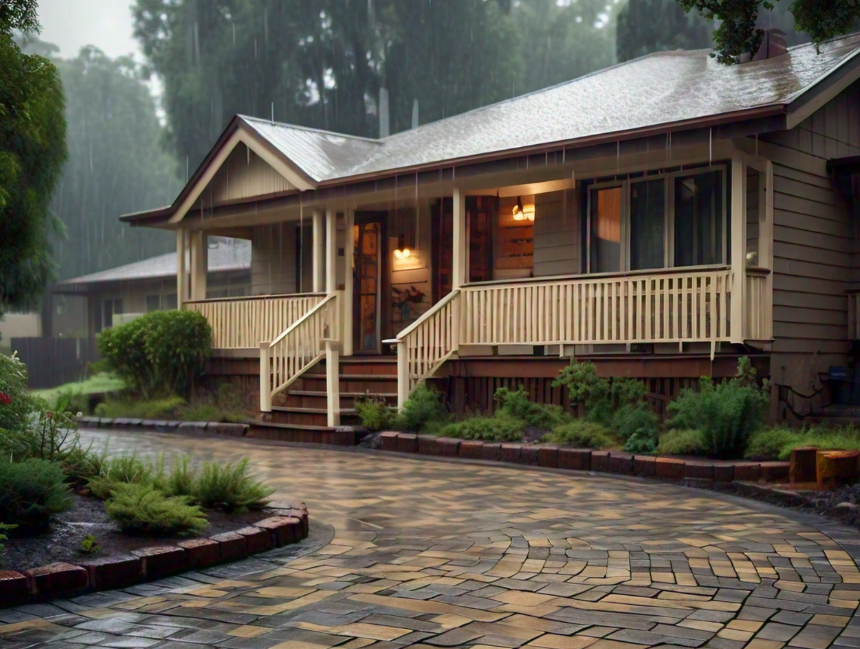Toronto’s winters are a sight, with snow-covered streets and glistening icicles. But for property owners with interlocking pavers, this winter wonderland can pose significant challenges. Ice formation can lead to cracks, shifts, and other damage that affects the appearance of your pavers and can be costly to repair. Explore paver protection strategies to keep your interlocking pavers safe during our frosty Toronto winters.
Understanding the Ice Menace
Before we dive into prevention, it’s crucial to understand why ice is such a threat to your pavers. When water seeps into the joints between pavers and freezes, it expands, pushing the pavers apart. This freeze-thaw cycle can occur multiple times throughout the winter, gradually weakening the structure of your paved area. The result? Uneven surfaces, loose pavers, and potential tripping hazards. You need paver protection.
Seal the Deal: The Importance of Sealing
A high-quality sealer is one of the most effective ways to protect your interlocking pavers. Think of it as a winter coat for your pavers! A good sealer creates a protective barrier that prevents water from penetrating the surface and joints. Here’s what you need to know:
- Choose the right sealer: Opt for a breathable, penetrating sealer designed for interlocking pavers.
- Time it right: Apply the sealer in late fall, before the first frost.
- Clean first: Ensure your pavers are thoroughly cleaned before sealing.
- Reapply as needed: Most sealers need to be reapplied every 2-3 years.
Proper Drainage: Your Pavers’ Best Friend
Water that can’t freeze can’t cause damage. That’s why proper drainage is crucial in preventing ice damage. Here are some tips to ensure your paved area stays dry:
- Maintain a slight slope: Ensure your paved area has a gentle slope away from buildings.
- Clear drainage paths: Keep nearby drains and gutters free of debris.
- Consider installing additional drainage: French or channel drains can help in problem areas.
The Salt Dilemma: To Use or Not to Use?
While salt (or other de-icing chemicals) can effectively melt ice, it can also damage your pavers. If you must use a de-icer, consider these alternatives:
- Sand or kitty litter: Provides traction without the damaging effects of salt.
- Calcium magnesium acetate: A salt-free de-icer that’s gentler on pavers.
- Heated mats: For small areas, heated mats can prevent ice formation altogether.
Proactive Measures: Stay Ahead of the Freeze
Prevention is always better than cure. Here are some proactive steps you can take:
- Regular cleaning: Remove debris and standing water before it can freeze.
- Prompt snow removal: Clear snow before it has a chance to melt and refreeze.
- Fill joints properly: Ensure joints between pavers are filled with polymeric sand.
- Address issues promptly: Fix any loose or sunken pavers before winter hits.
Professional Help: When to Call in the Experts
Sometimes calling in the professionals is best. Consider professional help for:
- Initial sealing application
- Comprehensive drainage solutions
- Repair of extensive damage
- Annual pre-winter inspections and maintenance
Investing in Prevention: A Smart Business Decision
Protecting your interlocking pavers from ice damage is more than just maintenance—it’s a smart investment. By taking these preventive measures, you’re not only preserving the beauty of your property but also avoiding costly repairs down the line. Well-maintained pavers enhance your property’s curb appeal and value, which is always good for business.
Remember, a little effort now can save you a lot of headache (and money) later. So, as we gear up for another Toronto winter, take some time to prepare your interlocking pavers. Your future self (and your wallet) will thank you when spring rolls around!
Stay warm, stay safe, and keep those pavers protected!










